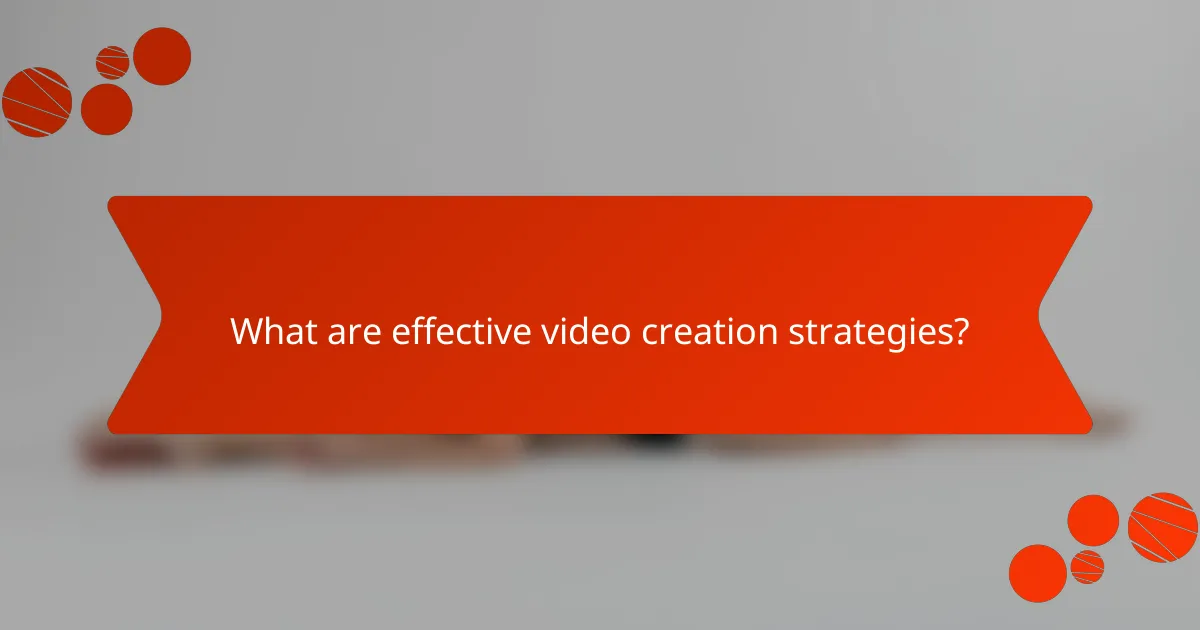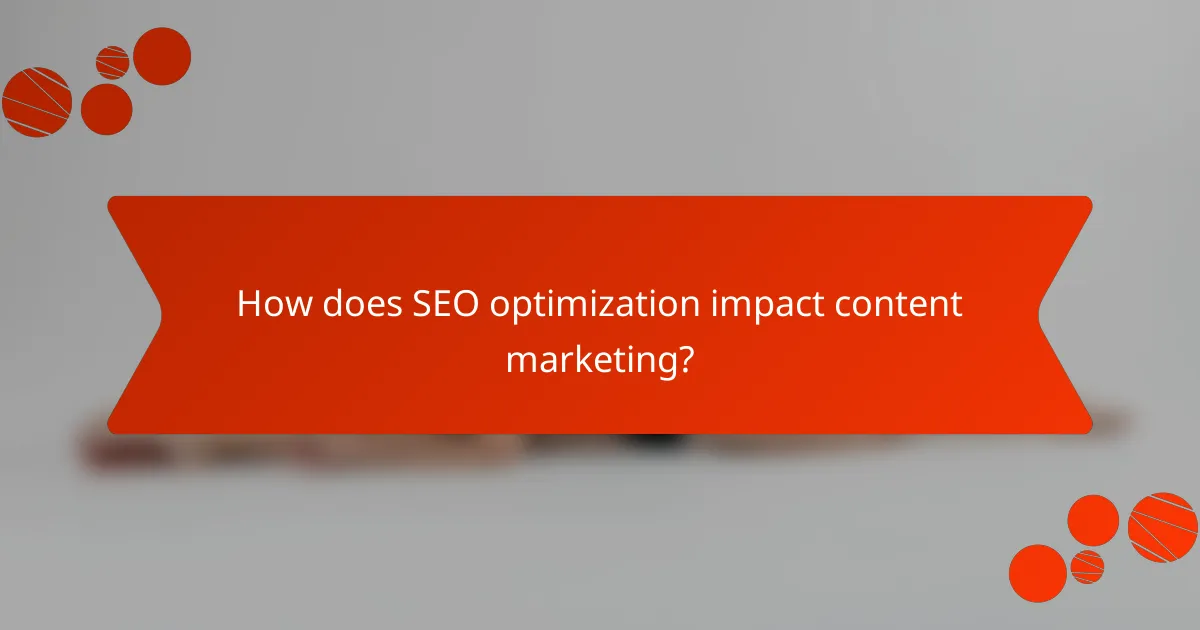Content marketing is a powerful strategy that encompasses blogging, video creation, and SEO optimization to engage audiences and drive conversions. By consistently delivering valuable content through blogs and videos, businesses can enhance their online presence and establish authority in their industry. Additionally, effective SEO practices ensure that this content reaches a wider audience, ultimately boosting traffic and engagement.

How can blogging enhance content marketing?
Blogging can significantly enhance content marketing by attracting and engaging a target audience, improving search engine visibility, and establishing a brand’s authority. By consistently publishing valuable content, businesses can foster relationships with potential customers and drive conversions.
Increased audience engagement
Blogging fosters increased audience engagement by providing valuable content that resonates with readers. Engaging posts encourage comments, shares, and discussions, creating a two-way communication channel with the audience. This interaction not only builds a loyal following but also helps businesses understand their audience’s needs and preferences.
To maximize engagement, consider using compelling headlines, visuals, and interactive elements like polls or quizzes. Regularly responding to comments can further enhance this connection.
Improved SEO rankings
Blogging contributes to improved SEO rankings by generating fresh content that search engines favor. Regularly updated blogs with relevant keywords can help a website rank higher in search results, making it more visible to potential customers. Incorporating internal and external links can also boost SEO performance.
To enhance SEO, focus on creating high-quality, keyword-rich content that answers common questions in your industry. Aim for a mix of short and long-tail keywords to capture a wider audience.
Establishing authority in niche
Blogging helps establish authority in a niche by showcasing expertise and providing valuable insights. Consistently sharing knowledgeable content positions a brand as a thought leader, which can attract a dedicated audience and build trust. This authority can lead to increased brand loyalty and customer retention.
To strengthen authority, consider guest blogging on reputable sites or collaborating with industry influencers. Sharing case studies and success stories can also enhance credibility.
Generating leads through calls-to-action
Effective blogging can generate leads through strategic calls-to-action (CTAs). By including CTAs within blog posts, businesses can guide readers toward desired actions, such as signing up for newsletters or downloading resources. This approach can turn casual readers into potential customers.
Ensure CTAs are clear and compelling, using actionable language. Experiment with different placements within the blog to find what works best for your audience.
Building community through comments
Blogging can build a community through the comments section, where readers can share their thoughts and experiences. This interaction creates a sense of belonging and encourages repeat visits. A thriving comments section can also provide valuable feedback and ideas for future content.
To foster community, actively moderate comments, encourage discussions, and acknowledge contributions. Consider highlighting insightful comments in future posts to motivate participation.

What are effective video creation strategies?
Effective video creation strategies involve combining engaging content with technical best practices to maximize viewer retention and reach. Key strategies include storytelling, SEO optimization, social media integration, eye-catching thumbnails, and data-driven improvements.
Utilizing storytelling techniques
Storytelling techniques can transform a video from a simple presentation into a compelling narrative that resonates with viewers. Start by defining a clear message or theme, then structure your video with a beginning, middle, and end to guide the audience through the experience.
Incorporate relatable characters and emotional elements to enhance connection. For example, a brand might share customer success stories to illustrate its impact, making the content more memorable and impactful.
Incorporating SEO best practices
Incorporating SEO best practices in video creation ensures that your content is discoverable by search engines. Use relevant keywords in your video title, description, and tags to improve visibility. Aim for a title that is both catchy and descriptive.
Additionally, consider creating transcripts for your videos, as they can enhance accessibility and provide additional text for search engines to index. This can significantly improve your video’s ranking on platforms like YouTube.
Leveraging social media platforms
Leveraging social media platforms is crucial for promoting your videos and reaching a wider audience. Share your videos across various channels, such as Facebook, Instagram, and TikTok, tailoring the content to fit each platform’s unique audience and format.
Engage with viewers through comments and shares to build a community around your content. Collaborating with influencers can also amplify your reach and introduce your videos to new audiences.
Creating engaging thumbnails
Creating engaging thumbnails is essential for attracting viewers to your videos. Thumbnails should be visually appealing and clearly represent the video’s content, often featuring bold text and vibrant images to catch the eye.
Consider A/B testing different thumbnail designs to determine which ones yield higher click-through rates. A good rule of thumb is to keep thumbnails simple yet informative, ensuring they stand out in crowded feeds.
Using analytics for optimization
Using analytics for optimization allows you to refine your video strategy based on viewer behavior. Monitor metrics such as watch time, click-through rates, and audience demographics to understand what works and what doesn’t.
Utilize tools like YouTube Analytics or social media insights to gather data. Regularly review this information to adjust your content, posting times, and promotional strategies to better align with audience preferences and trends.

How does SEO optimization impact content marketing?
SEO optimization significantly enhances content marketing by improving visibility in search engine results, leading to increased traffic and engagement. By effectively utilizing keywords and optimizing site structure, businesses can attract a larger audience and achieve their marketing goals.
Increased organic traffic
SEO optimization drives increased organic traffic by ensuring that content ranks higher in search engine results. This visibility leads to more visitors discovering your website through relevant searches, which can translate into thousands of additional visitors each month.
To maximize organic traffic, focus on keyword research to identify terms your target audience is searching for. Regularly updating content and optimizing meta tags can also help maintain or improve rankings over time.
Higher conversion rates
SEO-optimized content often results in higher conversion rates as it attracts users who are actively searching for specific solutions. When your content aligns with user intent, visitors are more likely to engage with your offerings and complete desired actions, such as signing up for newsletters or making purchases.
Incorporating clear calls to action (CTAs) within your content can further enhance conversion rates. Ensure that these CTAs are relevant to the content and strategically placed to guide users toward taking the next step.
Better user experience
SEO optimization contributes to a better user experience by improving site speed, mobile responsiveness, and navigation. A well-structured website allows users to find information quickly, which can reduce bounce rates and increase the time spent on site.
To enhance user experience, regularly test your website’s performance and make adjustments based on user feedback. Tools like Google PageSpeed Insights can help identify areas for improvement.
Enhanced brand visibility
Effective SEO practices increase brand visibility by placing your content in front of a larger audience. As your content ranks higher in search results, more users become familiar with your brand, leading to increased recognition and trust.
Utilizing social media and backlinks can further amplify brand visibility. Sharing optimized content across various platforms encourages engagement and drives traffic back to your website.
Long-term sustainability of content
SEO optimization fosters the long-term sustainability of content by ensuring it remains relevant and discoverable over time. Unlike paid advertising, which stops generating traffic once the budget is exhausted, well-optimized content can continue attracting visitors for months or even years.
To maintain sustainability, regularly update older content with fresh information and relevant keywords. This practice not only keeps your content current but also signals to search engines that your site is active and valuable to users.

What criteria should be considered for content marketing tools?
When selecting content marketing tools, consider integration capabilities, user-friendliness, and cost-effectiveness. These criteria ensure that the tools enhance your marketing efforts without complicating your workflow or exceeding your budget.
Integration capabilities with existing platforms
Effective content marketing tools should seamlessly integrate with your existing platforms, such as social media, email marketing, and analytics tools. This integration allows for streamlined workflows and better data sharing, enhancing the overall efficiency of your marketing strategy.
Look for tools that offer APIs or built-in connectors to popular platforms like WordPress, HubSpot, or Mailchimp. This ensures that you can easily manage your content across multiple channels without manual data entry.
User-friendliness and support
User-friendliness is crucial for maximizing the effectiveness of content marketing tools. A tool that is intuitive and easy to navigate will reduce the learning curve for your team, allowing for quicker implementation and better results.
Additionally, consider the level of customer support provided. Tools with robust support options, such as live chat, tutorials, and community forums, can help resolve issues quickly and keep your marketing efforts on track.
Cost-effectiveness for affiliate marketing
Cost-effectiveness is vital when choosing tools for affiliate marketing, as you want to ensure that your investment yields a good return. Look for tools that offer flexible pricing plans, allowing you to scale your usage based on your needs.
Evaluate the features included in each pricing tier to ensure you are not paying for unnecessary functionalities. Tools that provide trial periods or money-back guarantees can also help you assess their value before committing financially.

What are the best practices for affiliate marketing in content creation?
Effective affiliate marketing in content creation involves strategic planning, audience understanding, and quality content. Focus on building trust with your audience while promoting relevant products or services that align with their interests.
Understand Your Audience
Knowing your audience is crucial for successful affiliate marketing. Conduct surveys or analyze website analytics to identify their preferences, pain points, and purchasing behaviors. Tailor your content to address these aspects, ensuring that your recommendations resonate with their needs.
For example, if your audience consists of tech enthusiasts, create content that reviews the latest gadgets and includes affiliate links to purchase them. This targeted approach increases the likelihood of conversions.
Create High-Quality Content
High-quality content is essential for engaging your audience and driving affiliate sales. Focus on providing value through informative articles, engaging videos, or detailed product reviews. Ensure that your content is well-researched, visually appealing, and easy to read.
Incorporate storytelling techniques to make your content relatable. For instance, share personal experiences with a product to build authenticity and trust. This can significantly enhance your audience’s connection to your recommendations.
Optimize for SEO
Search engine optimization (SEO) is vital for increasing the visibility of your content. Use relevant keywords strategically throughout your articles, including in titles, headers, and meta descriptions. This helps search engines understand your content and rank it higher in search results.
Consider using tools like Google Keyword Planner to identify popular search terms related to your niche. Additionally, focus on building backlinks from reputable sites to improve your domain authority and search rankings.
Disclose Affiliate Relationships
Transparency is key in affiliate marketing. Always disclose your affiliate relationships to maintain trust with your audience. This can be done through clear statements in your content, such as “This post contains affiliate links, which means I may earn a commission at no extra cost to you.”
Adhering to regulations, such as the Federal Trade Commission (FTC) guidelines in the U.S., is essential. Failure to disclose can lead to penalties and damage your reputation.
Track Performance and Adjust Strategies
Regularly monitor the performance of your affiliate links to understand what works and what doesn’t. Use analytics tools to track clicks, conversions, and revenue generated from your affiliate marketing efforts.
Based on your findings, adjust your strategies accordingly. If certain products or content types perform better, focus more on those areas to maximize your affiliate income. Experiment with different formats, such as video reviews or listicles, to see what resonates best with your audience.


